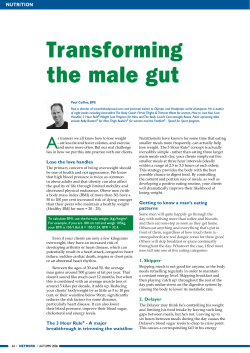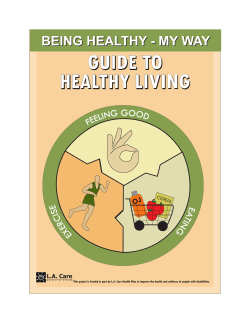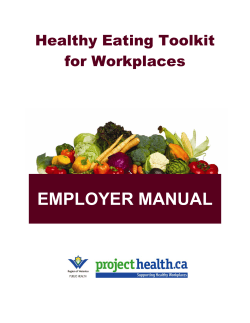
avoid portion size pitfalls How to
Check out these websites for more portion size tips • The Portion Distortion Quiz from the National Heart Lung and Blood Institute (NHLBI) (http://hin.nhlbi.nih.gov/portion/) shows how portion sizes of some common foods have changed over the years. • Food labels can help you understand that portion sizes are often larger than you think. Click the links below to learn how to use the Nutrition Facts Label on food packages: > How to Understand and Use the Nutrition Facts Label, Food and Drug Administration, Center for Food Safety and Applied Nutrition. http://www.cfsan.fda.gov/~dms/foodlab.html > Test Your Food Label Knowledge (quiz), Food and Drug Administration, Center for Food Safety and Applied Nutrition. http://www.cfsan.fda.gov/~dms/flquiz1.html • Take the NHLBI Visual Reality quiz (http://nhlbisupport.com/chd1/visualreality/vi sualreality.htm) to test your skills at estimating serving sizes. • Use this handy Serving Size Wallet card from NHLBI (http://hin.nhlbi.nih.gov/portion/servingcard7.pdf) to help estimate the right amount to eat. Or check out www.MyPyramid.gov for detailed information on how much to eat from each food group without eating more calories than you need. How to avoid portion size pitfalls to help manage your weight. When eating at many restaurants, it’s hard to miss that portion sizes have gotten larger in the last few years. The trend has also spilled over into the grocery store and vending machines, where a bagel has become a BAGEL and an “individual” bag of chips can easily feed more than one. Research shows that people unintentionally consume more calories when faced with larger portions. This can mean significant excess calorie intake, especially when eating high-calorie foods. Here are some tips to help you avoid some common portion-size pitfalls: Department of Health and Human Services Centers for Disease Control and Prevention National Center for Chronic Disease Prevention and Health Promotion Division of Nutrition and Physical Activity Department of Health and Human Services Centers for Disease Control and Prevention F R UIT SNA CK I NG ON C RT EA TI N G WH O S 3 minimize the temptation of second and third helpings when eating at home, serve the food on individual plates, instead of putting the serving dishes on the table. Keeping the excess food out of reach may discourage overeating. M O package, the more people consume from it without realizing it. To minimize this effect: • Divide up the contents of one large package into several smaller containers to help avoid over-consumption. • Don’t eat straight from the package. Instead, serve :-( M O V E B A the food in a small bowl or container. C HEAD 2 STEP S K :-) EPS S AT E PL UA L NG S O N IN DIVID M O VI R GF SE R E AT I N Portion control when eating out. Many restaurants serve more food than one person needs at one meal. Take control of the amount of food that ends up on your plate by splitting an entrée with a friend. Or, ask the wait person for a “to-go” box and wrap up half your meal as soon as it’s brought to the table. OW Y W IT H F R UIT B Be aware of large packages. For some reason, the larger the ST ) M AD OVE AHE 3 A VE ND 3 :- ST EP S S P LIT AN D ES ON THE TABLE E EP DIS H E BACK TV CA I NG PI .... G O BACK MOV TU RN M OVE AHEAD 4 CE ( ER V FF TA S :T FA LL IT H A F R EE W IEN R NT ( ST Portion control when eating in. To :-) REPLA KE SN AS HO G :-) :- START HERE T S AC NG U EP KI consume more when they have easy access to food. Make your home a “portion friendly zone.” • Replace the candy dish with a fruit bowl. • Store especially tempting foods, like cookies, chips, or ice cream, out of immediate eyesight, like on a high shelf or at the back of the freezer. Move the healthier food to the front at eye level. • When buying in bulk, store the excess in a place that’s not convenient to get to, such as a high cabinet or at the back of the pantry. Do you get caught in portion size pitfalls? Roll the dice and move along the path. (Use dice and players from another board game.) Follow the instructions for each shortcut or pitfall you land on. The turn then moves to the next player. Get on the path to proper portion control! ST When eating or snacking in front of the TV, put the amount that you plan to eat into a bowl or container instead of eating straight from the package. It’s easy to overeat when your attention is focused M THE B on something else. FRO A Directions L AD Portion control in front of the TV. Out of sight, out of mind. People tend to I LE 4S TEPS Go ahead, spoil your dinner. We learned as children not to snack before a meal for fear of “spoiling our dinner.” Well, it’s H E time to forget that old rule. If you A :-) M O VE feel hungry between meals, eat a healthy snack, like a piece of fruit or small salad, to avoid overeating during your next meal. CONGRATULATIONS YOU’RE A WINNER! L .... G O B A C K FA L T I P :-( S L E F T OU T KIE O CO AL GE A R G E PA C K A F R UIT SNA CK I NG ON C RT EA TI N G WH O S 3 minimize the temptation of second and third helpings when eating at home, serve the food on individual plates, instead of putting the serving dishes on the table. Keeping the excess food out of reach may discourage overeating. M O package, the more people consume from it without realizing it. To minimize this effect: • Divide up the contents of one large package into several smaller containers to help avoid over-consumption. • Don’t eat straight from the package. Instead, serve :-( M O V E B A the food in a small bowl or container. C HEAD 2 STEP S K :-) EPS S AT E PL UA L NG S O N IN DIVID M O VI R GF SE R E AT I N Portion control when eating out. Many restaurants serve more food than one person needs at one meal. Take control of the amount of food that ends up on your plate by splitting an entrée with a friend. Or, ask the wait person for a “to-go” box and wrap up half your meal as soon as it’s brought to the table. OW Y W IT H F R UIT B Be aware of large packages. For some reason, the larger the ST ) M AD OVE AHE 3 A VE ND 3 :- ST EP S S P LIT AN D ES ON THE TABLE E EP DIS H E BACK TV CA I NG PI .... G O BACK MOV TU RN M OVE AHEAD 4 CE ( ER V FF TA S :T FA LL IT H A F R EE W IEN R NT ( ST Portion control when eating in. To :-) REPLA KE SN AS HO G :-) :- START HERE T S AC NG U EP KI consume more when they have easy access to food. Make your home a “portion friendly zone.” • Replace the candy dish with a fruit bowl. • Store especially tempting foods, like cookies, chips, or ice cream, out of immediate eyesight, like on a high shelf or at the back of the freezer. Move the healthier food to the front at eye level. • When buying in bulk, store the excess in a place that’s not convenient to get to, such as a high cabinet or at the back of the pantry. Do you get caught in portion size pitfalls? Roll the dice and move along the path. (Use dice and players from another board game.) Follow the instructions for each shortcut or pitfall you land on. The turn then moves to the next player. Get on the path to proper portion control! ST When eating or snacking in front of the TV, put the amount that you plan to eat into a bowl or container instead of eating straight from the package. It’s easy to overeat when your attention is focused M THE B on something else. FRO A Directions L AD Portion control in front of the TV. Out of sight, out of mind. People tend to I LE 4S TEPS Go ahead, spoil your dinner. We learned as children not to snack before a meal for fear of “spoiling our dinner.” Well, it’s H E time to forget that old rule. If you A :-) M O VE feel hungry between meals, eat a healthy snack, like a piece of fruit or small salad, to avoid overeating during your next meal. CONGRATULATIONS YOU’RE A WINNER! L .... G O B A C K FA L T I P :-( S L E F T OU T KIE O CO AL GE A R G E PA C K A Check out these websites for more portion size tips • The Portion Distortion Quiz from the National Heart Lung and Blood Institute (NHLBI) (http://hin.nhlbi.nih.gov/portion/) shows how portion sizes of some common foods have changed over the years. • Food labels can help you understand that portion sizes are often larger than you think. Click the links below to learn how to use the Nutrition Facts Label on food packages: > How to Understand and Use the Nutrition Facts Label, Food and Drug Administration, Center for Food Safety and Applied Nutrition. http://www.cfsan.fda.gov/~dms/foodlab.html > Test Your Food Label Knowledge (quiz), Food and Drug Administration, Center for Food Safety and Applied Nutrition. http://www.cfsan.fda.gov/~dms/flquiz1.html • Take the NHLBI Visual Reality quiz (http://nhlbisupport.com/chd1/visualreality/vi sualreality.htm) to test your skills at estimating serving sizes. • Use this handy Serving Size Wallet card from NHLBI (http://hin.nhlbi.nih.gov/portion/servingcard7.pdf) to help estimate the right amount to eat. Or check out www.MyPyramid.gov for detailed information on how much to eat from each food group without eating more calories than you need. How to avoid portion size pitfalls to help manage your weight. When eating at many restaurants, it’s hard to miss that portion sizes have gotten larger in the last few years. The trend has also spilled over into the grocery store and vending machines, where a bagel has become a BAGEL and an “individual” bag of chips can easily feed more than one. Research shows that people unintentionally consume more calories when faced with larger portions. This can mean significant excess calorie intake, especially when eating high-calorie foods. Here are some tips to help you avoid some common portion-size pitfalls: Department of Health and Human Services Centers for Disease Control and Prevention National Center for Chronic Disease Prevention and Health Promotion Division of Nutrition and Physical Activity Department of Health and Human Services Centers for Disease Control and Prevention
© Copyright 2025





















